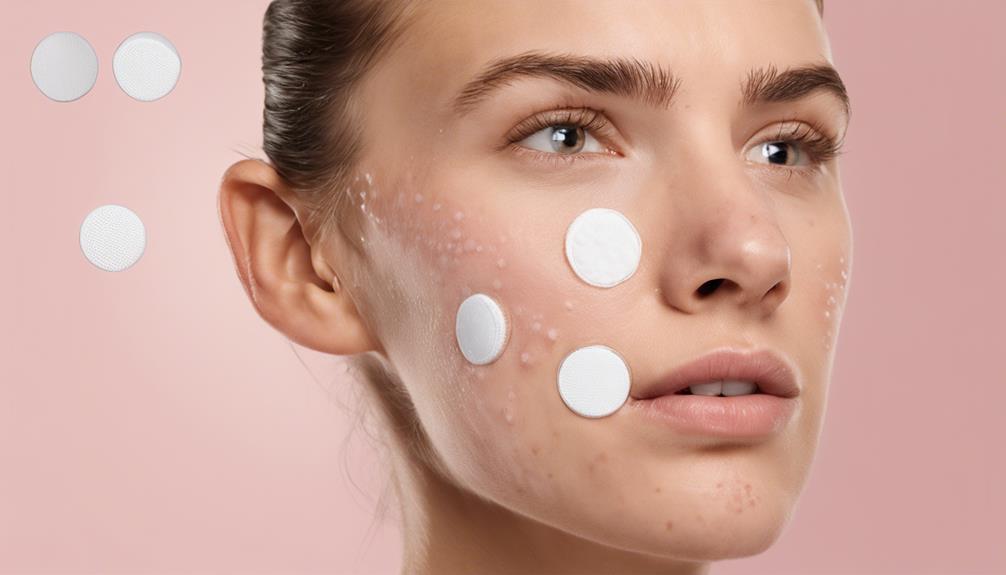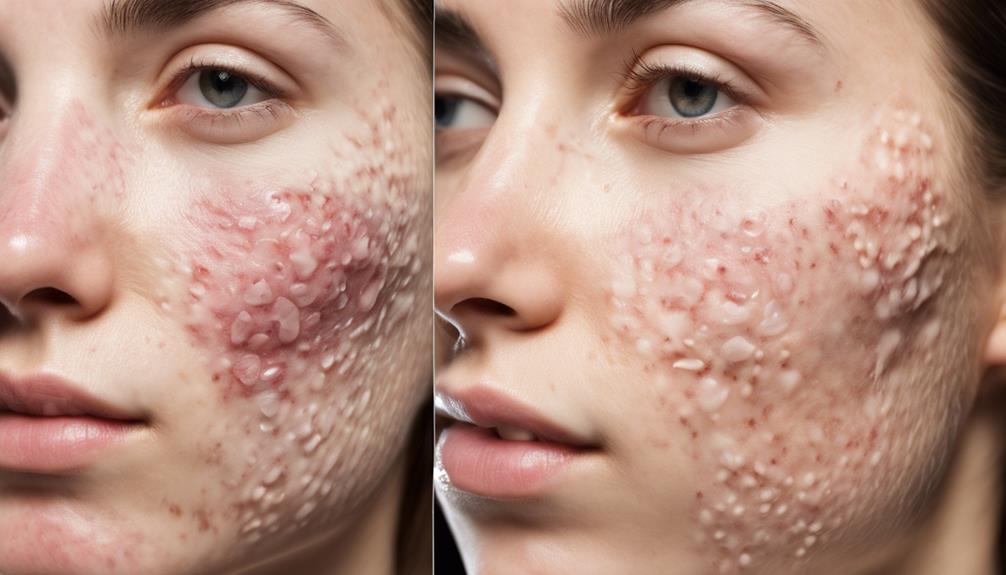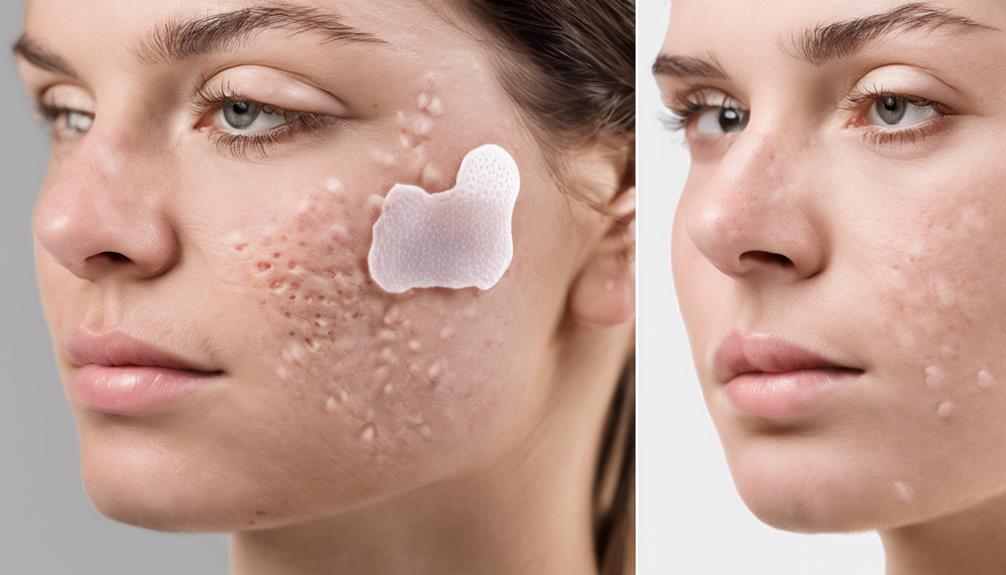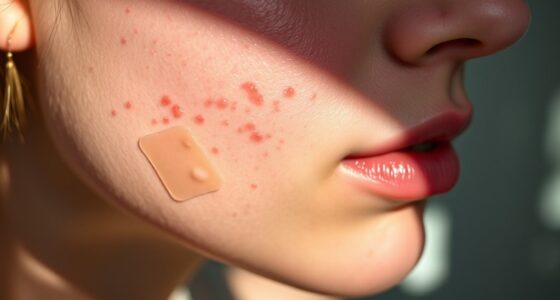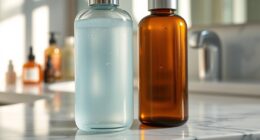Acne patches utilize hydrocolloid to draw out impurities, form a protective barrier, and deliver active ingredients tailored to specific skin concerns. They are intended for overnight application and effectively target various types of acne. The hydrocolloid absorbs excess oil and fluids, accelerates the healing process, and helps prevent scarring. These patches aid in reducing inflammation, lowering the risk of scarring, and discouraging the urge to pick at pimples. Popular brands such as COSRX and Mighty Patch offer solutions for a range of skin problems. Correct application on clean, dry skin, following recommended wear times, and considering potential side effects are crucial for optimal results. Explore more about the benefits and proper usage of acne patches.
Key Takeaways
- Hydrocolloid absorbs oil and fluids, aiding in pimple drainage and flattening.
- Forms a protective barrier over pimples, promoting skin recovery and preventing scarring.
- Active ingredients target specific skin concerns and accelerate healing.
- Work overnight to draw out impurities, reducing inflammation and preventing further irritation.
- Suitable for various acne lesions, offering effective treatment for different skin concerns.
Understanding Acne and Pimple Patches
Acne and pimple patches work by utilizing hydrocolloid, a gel-forming material that aids in absorbing fluids and promoting healing while preventing scarring. These patches form a protective barrier over pimples, reducing the urge to touch them and minimizing the risk of infection.
The hydrocolloid material is particularly effective for open, draining, healing pustules, papules, and cysts, expediting the healing process. Some pimple patches go the extra mile by incorporating active ingredients like salicylic acid, tea tree oil, hyaluronic acid, niacinamide, or benzoyl peroxide, targeting specific skin concerns to provide a thorough acne treatment.
They're designed to work overnight, sometimes making pimples disappear by morning. Suitable for various types of acne lesions, these patches are a convenient and reliable addition to your skincare routine.
Embracing pimple patches can be a game-changer in your skincare regimen, offering a straightforward and effective way to tackle acne troubles.
Mechanism of Pimple Patch Action
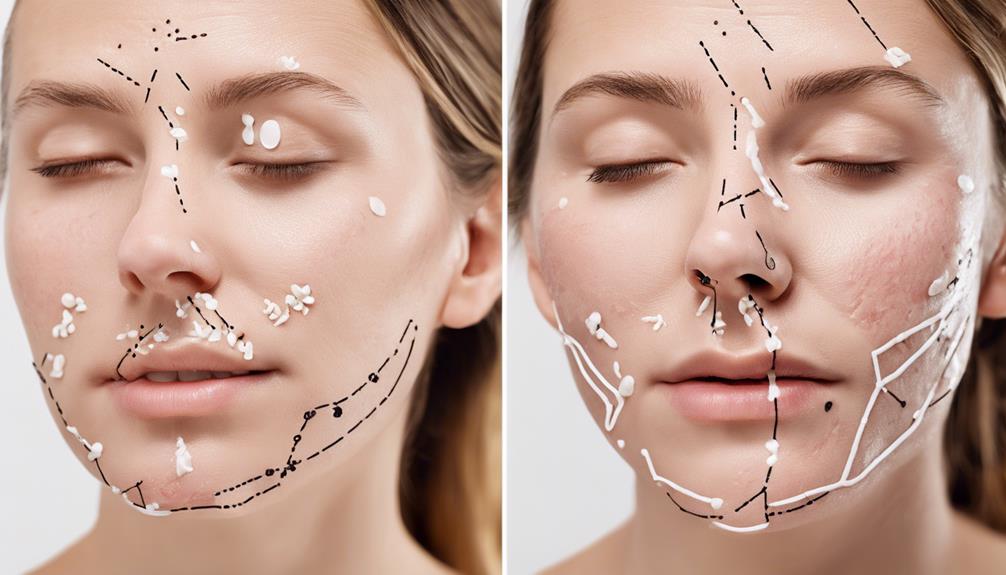
By forming a protective barrier over the affected area, pimple patches effectively safeguard the pimple from external bacteria, aiding in its healing process. These hydrocolloid patches act as a physical barrier, preventing dirt and bacteria from entering the pimple and causing further irritation. Additionally, the absorbent nature of the patches helps to draw out excess oil, pus, and impurities, promoting faster healing and reducing the size of the blemish.
Here are three key ways pimple patches work their magic:
- Absorb Excess Oil: The hydrocolloid material in the patches absorbs excess oil, pus, and impurities from the pimple, facilitating the healing process and preventing further inflammation.
- Reduce Inflammation: Patches with added ingredients like salicylic acid or tea tree oil target inflammation and bacteria, assisting in the treatment of the pimple and promoting a clearer complexion.
- Adhesive Nature: The adhesive quality of pimple patches ensures that the active ingredients remain in direct contact with the pimple, enhancing their effectiveness in treating the affected area and speeding up the healing process.
Role of Hydrocolloid in Patch Function

Using a gel-forming material, hydrocolloid in pimple patches effectively absorbs excess oil and fluids from pimples. This helps create an ideal environment for promoting faster healing and preventing scarring.
The inner layers of hydrocolloid patches work to draw out impurities from pimples, while the outer layers serve as a protective barrier for the skin. By effectively draining and flattening raised pimples with visible pus, hydrocolloid pimple patches can aid in the healing process.
Hydrocolloid is a key ingredient in pimple patches due to its ability to absorb excess oil and promote skin recovery. Its gel-like properties make it ideal for maintaining moisture levels that are conducive to quicker healing. By preventing the formation of scabs and keeping the affected area hydrated, hydrocolloid patches can reduce the risk of scarring.
This dual action of absorbing impurities and maintaining a moist environment makes hydrocolloid an essential component in pimple patches for effectively treating acne breakouts.
Absorption and Healing Process
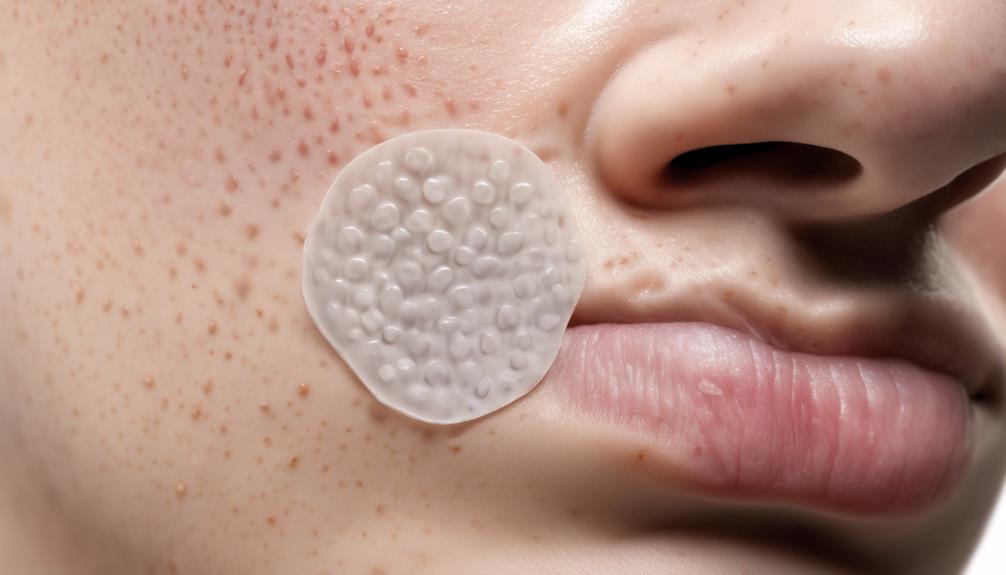
Drawing out impurities and promoting a clean, moist healing environment, the absorption and healing process of pimple patches is essential for aiding in faster recovery from acne breakouts. The hydrocolloid material in these patches plays a vital role in this process:
- Absorption: Pimple patches work by absorbing excess oil, pus, and fluids from the pimple. This helps to draw out impurities and bacteria, creating an environment conducive to healing.
- Healing Process: The hydrocolloid material in pimple patches not only absorbs impurities but also aids in faster healing. By keeping the area moist and protected, the patches contribute to the skin's natural healing process.
- Protective Barrier: Patches create a protective barrier over the pimple, preventing further infection and reducing the risk of scarring. This barrier also helps minimize the temptation to touch or pick at the pimple, allowing it to heal without interference.
Inflammation Reduction and Scar Prevention
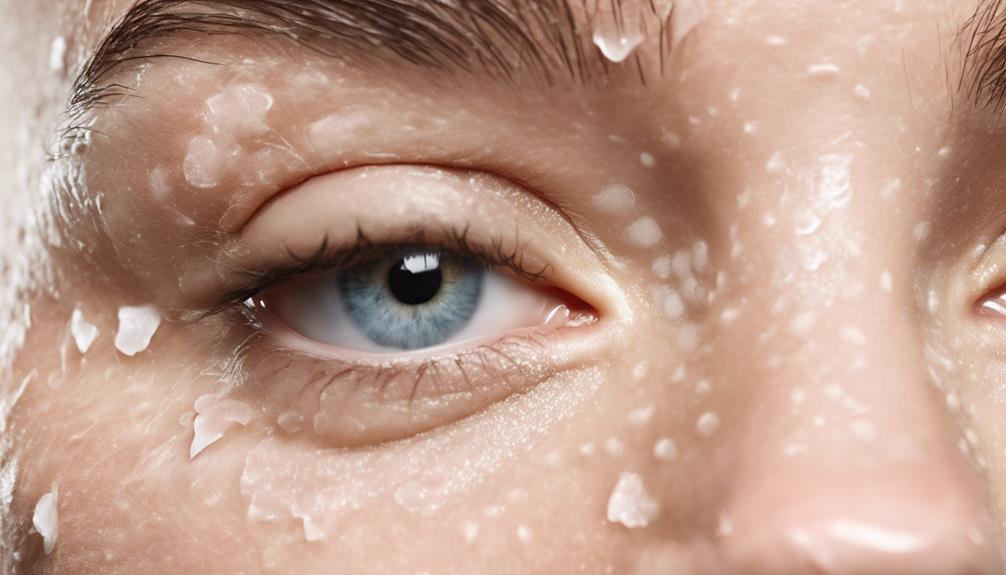
Pimple patches work by reducing inflammation and preventing scarring through their ability to absorb excess oil and pus, creating a protective barrier against bacteria.
These patches not only accelerate the healing process but also discourage picking or squeezing pimples, thereby minimizing the risk of further irritation and potential scarring.
Inflammation Control Methods
To effectively manage acne-related inflammation and prevent scarring, controlling the body's response to pimple formation is essential. Pimple patches play a vital role in this process by providing targeted care. Here are three key methods they use for inflammation control and scar prevention:
- Pus Absorption: Hydrocolloid patches work by absorbing excess oil and pus from the pimple, reducing swelling and redness.
- Protective Barrier: These patches create a protective barrier over the pimple, preventing further irritation and minimizing inflammation.
- Salicylic Acid Infusion: Some patches contain salicylic acid, which specifically targets inflammation, aiding in overall inflammation control.
Scar Prevention Techniques
When addressing scar prevention techniques related to inflammation reduction and scar prevention, a key strategy involves creating a protective barrier over the affected area. This protective barrier not only shields the pimple from external irritants but also prevents picking, reducing the likelihood of scarring.
Pimple patches aid in scar prevention by absorbing excess oil, promoting skin regeneration, and flattening the pimple. Ingredients like salicylic acid found in some patches help exfoliate the skin, targeting bacteria and further supporting scar prevention. By maintaining a moist environment, pimple patches facilitate faster healing, decreasing the chances of scarring.
Incorporating these scar prevention techniques can help promote clearer skin and minimize the long-term effects of acne breakouts.
Healing Acceleration Tips
Implementing proper skincare routines can greatly contribute to accelerating the healing process of acne lesions, aiding in inflammation reduction and scar prevention.
- Maintaining a Moist Environment: Pimple patches create a barrier that keeps the area moist, promoting faster healing and reducing inflammation.
- Absorbing Excess Oil: By absorbing excess oil and bacteria, pimple patches help prevent scarring and minimize the risk of hyperpigmentation.
- Protecting the Pimple: These patches act as a protective shield, preventing external factors from aggravating the acne lesion and allowing the skin to heal naturally.
Types and Varieties of Patches

Exploring the diverse range of types and varieties, pimple patches offer tailored solutions for various facial blemishes. Hydrocolloid patches are perfect for raised pimples with visible pus, aiding in draining and flattening the blemish effectively. These patches come in various shapes and sizes, specifically designed for different types of pimples on the face. Adhesives such as acrylic, silicone, and hydrogel are utilized to secure the patch in place over the pimple, ensuring it stays put for best effectiveness.
When it comes to types of patches, you can choose from non-medicated hydrocolloid patches, medicated patches targeting bacteria and inflammation, and microneedling patches for deeper delivery of active ingredients. Additionally, pimple patches vary in visibility on the skin; some are clear and subtle, while others may be more noticeable. This variety allows you to select based on personal preference, ensuring that you find a patch that suits your style and comfort level.
Popular and Effective Brands
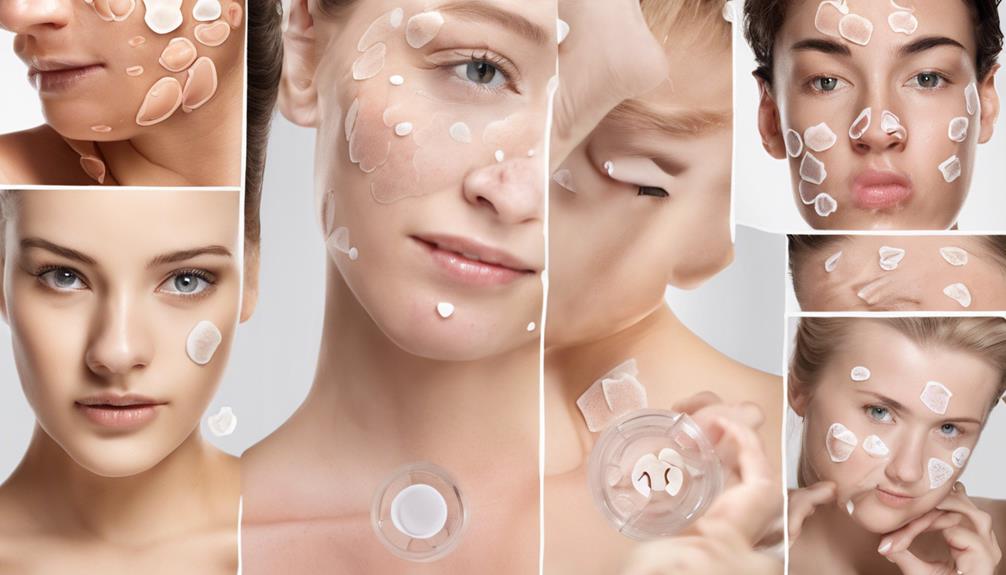
Popular brands such as COSRX Acne Pimple Master Patch, Mighty Patch Original, and Rael Acne Pimple Healing Patch are widely recognized for their effectiveness in treating acne blemishes.
- COSRX Acne Pimple Master Patch: These ultra-thin and clear patches are virtually invisible on the skin. They contain salicylic acid to help reduce inflammation and absorb excess oil, promoting faster healing of pimples.
- Mighty Patch Original: Made with hydrocolloid technology, these patches effectively draw out pus and impurities from pimples, aiding in the healing process. They're a popular choice for their ability to absorb impurities while protecting the skin.
- Rael Acne Pimple Healing Patch: Infused with tea tree oil and calendula oil, these patches offer anti-inflammatory and soothing properties to calm irritated skin. The natural ingredients help in reducing redness and promoting skin recovery.
These brands provide a range of effective solutions for acne-prone skin, addressing various concerns such as inflammation, oil absorption, and promoting healing.
Application and Usage Tips
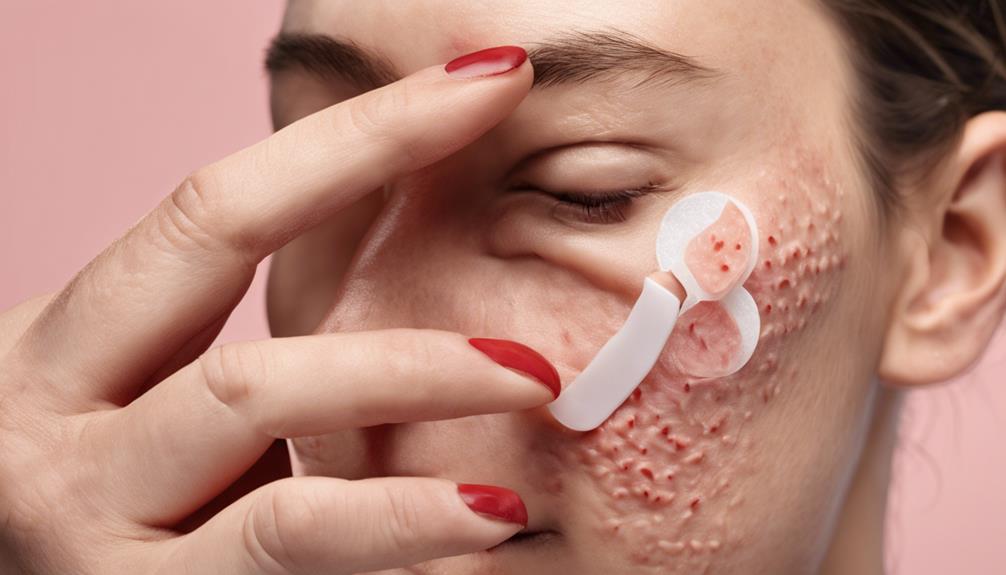
When applying acne pimple patches, ensure the skin is clean and dry for better adhesion.
It's crucial to wait until the pimple is open or draining before using the patch to allow it to absorb fluids effectively.
Follow the instructions on the packaging for the recommended wear time to achieve best results.
Proper Patch Placement
For maximum effectiveness of acne pimple patches, proper placement is essential in covering the blemish entirely. When applying acne patches, follow these tips for best results:
- Identify the blemish: Locate the specific type of acne you want to target for treatment.
- Cleanse the skin: Prepare the area by cleansing it to remove excess oil and dirt before applying the patch.
- Apply the patch correctly: Place the patch sticky-side down on the blemish, making sure it covers the entire area following the product's specific instructions.
Following these steps will help maximize the benefits of acne pimple patches for your skin type and ensure effective treatment of breakouts.
Duration of Application
For best outcomes, pimple patches should be worn for several hours to overnight, allowing for the proper absorption of oil and bacteria from the blemish. The recommended amount of time for wearing these hydrocolloid patches is essential for them to work effectively on the acne spot.
This extended wear time enables the inner layer of the patch to draw out impurities, promoting faster healing and reduced inflammation. By following the specified duration, you can protect your skin from further irritation and help the patch do its job efficiently.
Consistency in using the patches for the right amount of time can greatly improve the appearance of your blemishes and enhance the overall effectiveness of the treatment.
Removing and Replacing
Let's make sure to gently peel off the pimple patch, starting from the edge to prevent skin irritation, before applying a new one for better adhesion and effectiveness.
- Cleanse: Before applying a new patch, cleanse the area to remove any dirt or oils that could hinder adhesion.
- Follow Manufacturer Instructions: Adhere to the specific instructions provided by the patch manufacturer for best skin care benefits.
- Replace When Needed: Replace the patch with a fresh one if it becomes dislodged or loses its adhesive properties to maintain hygiene and effectiveness.
Considerations and Potential Side Effects
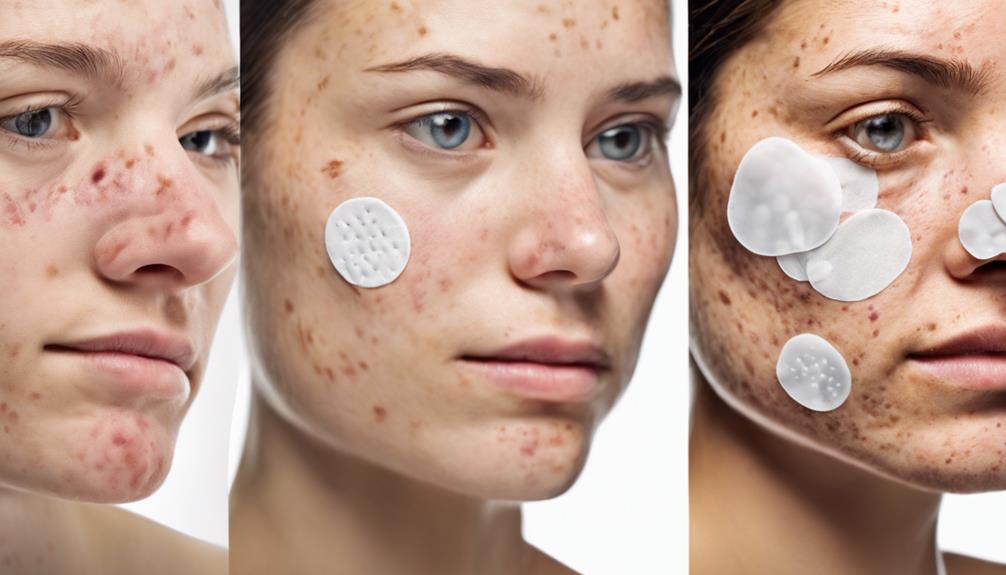
Considering potential side effects, it's vital to be aware of how acne pimple patches work and their impact on skin sensitivity.
Hydrocolloid patches, generally safe for most users, have minimal side effects. However, patches containing benzoyl peroxide or salicylic acid may lead to skin sensitivity in some individuals. If allergic reactions occur, the ingredients in pimple patches can leave red marks on sensitive skin.
Individuals with sensitive skin should opt for patches without added ingredients to prevent potential irritation. While hydrocolloid patches effectively promote healing, users must remain cautious of any adverse reactions and discontinue use if skin sensitivity develops.
It's essential to pay attention to how the patches interact with your face, especially if you have sensitive skin, to mitigate any potential side effects. Always prioritize your skin's health and choose products that work best for your skin type to maintain a clear and healthy complexion.
Frequently Asked Questions
Do Pimple Patches Work on Unpopped Pimples?
Pimple patches are effective on unpopped pimples as they create a barrier to prevent picking, promote faster healing, and reduce inflammation. They work by maintaining a moist environment over unpopped pimples, aiding in preventing scarring and speeding up the healing process.
The hydrocolloid material in pimple patches absorbs excess oil and pus from unpopped pimples, aiding in flattening and drying them out. Patches with added ingredients like salicylic acid or tea tree oil target bacteria and inflammation for enhanced treatment.
Are Pimple Patches Actually Good for Acne?
Pimple patches are indeed good for acne. They create a protective barrier against bacteria, absorb excess oil, and promote faster healing. By minimizing picking, they help prevent scarring and reduce inflammation.
Hydrocolloid patches specifically aid in improving the appearance of pimples. These patches work best for mild to moderate acne, providing an ideal environment for skin recovery.
What Do Pimple Patches Pull Out?
Pimple patches pull out excess oil, impurities, pus, and fluids from the pimple. By absorbing these substances, they speed up the healing process and reduce inflammation. Additionally, the patches create a protective barrier that helps prevent scarring and keeps the pimple clean.
The hydrocolloid material in the patch is key to this process, effectively pulling out the pimple's contents and aiding in a quicker recovery.
Why Do Pimple Patches Turn White?
When using pimple patches, the white color change indicates the absorption of oil, pus, and impurities from the skin. This transformation signals that the patch is actively drawing out fluids and bacteria, aiding in the healing process.
The hydrocolloid material saturates with extracted substances, turning the patch white. This visual confirmation of effectiveness can provide satisfaction while treating the pimple.
What Are the Benefits of Using Acne Pimple Patches?
The ultimate pimple patch guide provides a quick and effective solution to acne. These patches help to reduce inflammation, prevent scarring, and minimize the appearance of pimples. They also protect the affected area from further irritation and bacteria, promoting faster healing and clearer skin.
Conclusion
To sum up, acne pimple patches are a popular and effective way to treat pimples and speed up the healing process.
One interesting statistic to note is that hydrocolloid patches have been shown to absorb up to 50 times their weight in fluid, helping to reduce inflammation and prevent scarring.
By using these patches correctly and consistently, individuals can see improvements in their skin and overall complexion.
Emma founded Patchology.org with a vision to simplify skincare through the innovative use of patches. With over a decade of experience in skincare blogging, Emma ensures that every piece of content on the site meets the highest standards of clarity and integrity. She loves curating content that makes skincare accessible to everyone.
